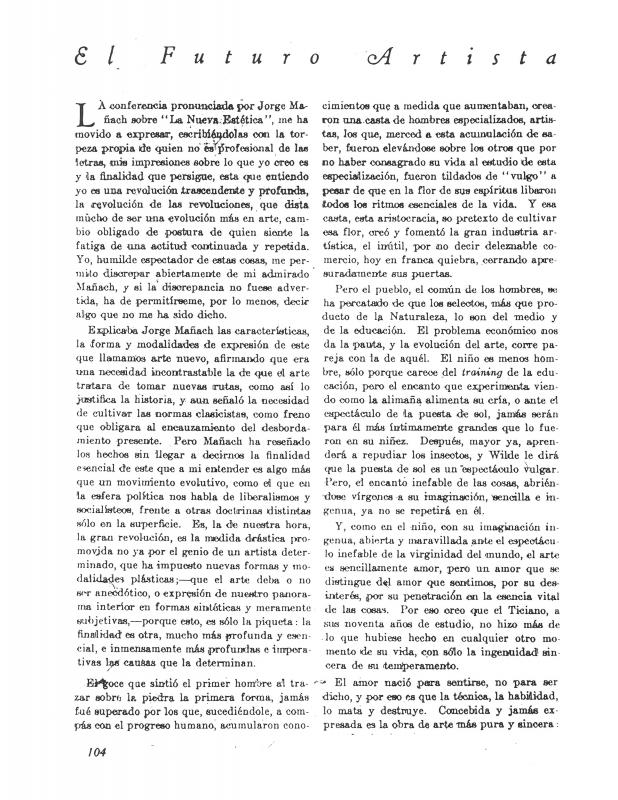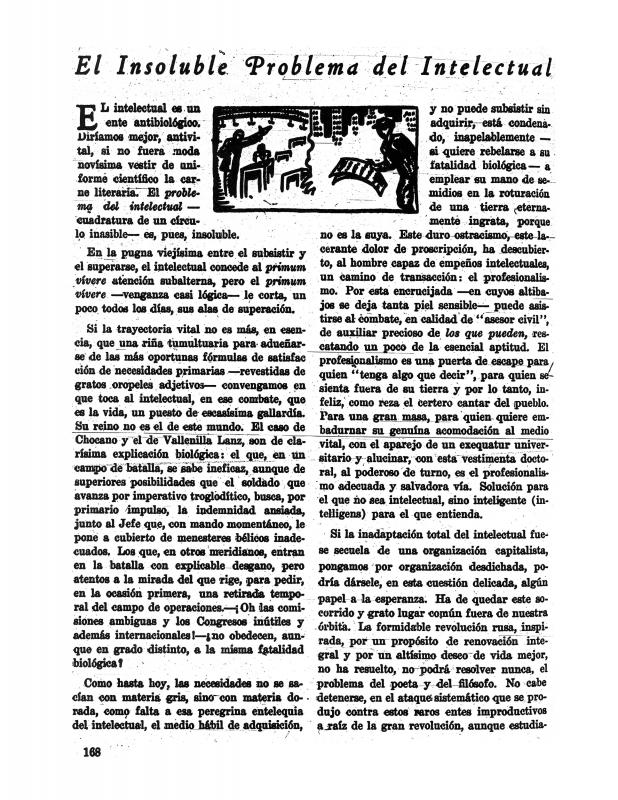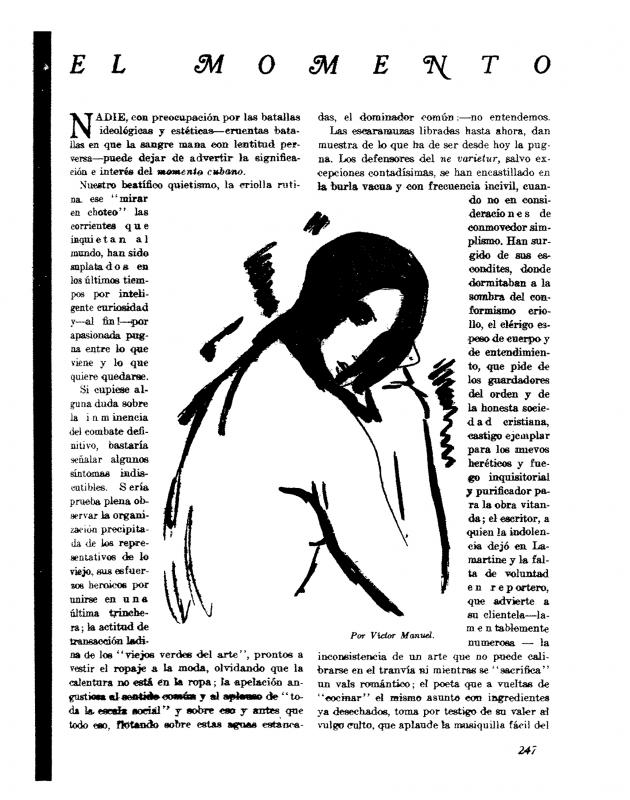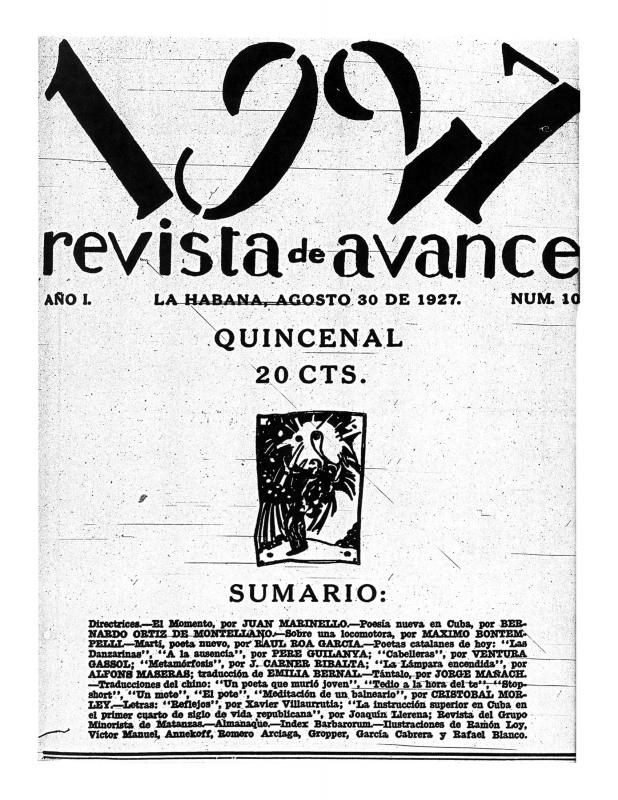In the inaugural text of Revista de avance, “Al levar el ancla,” the editorial team stated that the modest number of editors reflected the simplicity and rigor that characterized the publication. However, analyzing its first year, twelve issues later, it became clear that one of its most important contributions was bringing together a significant number of intellectuals from Cuba, Latin America, and Europe. This was a heterogeneous group that included writers, philosophers, literary and art critics, translators, politicians, journalists, and artists. What unified them was the feeling of breaking with the past and the desire to define the ethical, aesthetic, and political principles of an intellectual avant-garde. Even in the earliest issues, Mañach pinpointed that impetus for renewal in the historical transformations carried out by new generations. Those beginnings led to a search to define what was new and Cuban at the same time. In other words, they were seeking whatever would reflect an awareness of social, political, and cultural renewal starting with the concept of an independent nation. In this regard, the journal was not a platform on which to present the aesthetic tastes of one class. It was, instead, a space for considering the values that represented certain aesthetic trends in Latin American art and culture, particularly as they related to avant-garde movements taking place in Europe. The essays written by the Catalan art critic Martí Casanovas reflected the strong desire to merge aesthetic with ideological ideals. In his texts on 1927: Exposición de Arte Nuevo, Casanovas proposes that an avant-garde movement is possible through militancy, through the political commitment of artists and writers. The journal reflects the importance of the thinking of José Martí to Cuban intellectuals, who considered the poet to be the new artist par excellence, since his work integrated ethical and aesthetic ideals (see “Martí: Poeta Nuevo” below). The texts that make up the first volume of the journal are reference documents for understanding the main debates and ideas incubating among the artistic and intellectual avant-garde in Cuba and throughout Latin America. The pages of avance show how the period of the Republic was one of rupture and simultaneously of national unification. It could also be described as a time when strong tensions arose between nationalist and universalist ideas and between the new and the traditional. The essays and articles in the journal revolve around these paradoxes, which represent the character of a generation that was committed and prepared to take chances on the uncertain paths of the searches ahead of them. [For other essays and texts published in Revista de avance, see the following in the ICAA digital archive: by Martí Casanovas “Almanaque” (doc. no. 1299709), “Almanaque: Exposición Gattorno” (doc. o. 1298711), “El capitalismo y la inteligencia” (doc. no. 1299384), “Nuevos Rumbos: La exposición de ‘1927’” (doc. no. 1280155), and “Pierre Flouquet” (doc. no. 1299881); “[El arte nuestro debe ser instintiva o intuitivamente americano...],” by Víctor Andrés Belaúnde (doc. no. 832310); “[Basta con que revele una honda...],” by Carlos Préndez Saldías (doc. no. 832258); “Causerie sobre el Salón de Bellas Artes,” by Adia M. Yunkers (doc. no. 1298799); “[Creo que el artista americano...],” by Ildefonso Pereda Valdés (doc. no. 832328); “Dibujos escolares” (anonymous) (doc. no. 1299805); “Diego Rivera,” by Alejo Carpentier (doc. no. 1299962); “Eduardo Abela: pintor cubano,” by Adolfo Zamora (doc. no. 1280283); “El futuro artista,” by Eduardo Abela (doc. no. 1299789); by Juan Marinello “El insoluble problema del intelectual” (doc. no. 1299897), and “El momento” (doc. no. 1125671); “El prejuicio en el ritmo intelectual de las épocas,” by Francisco Ichaso (doc. no. 1299741); “El problema internacional de Centro América y Cuba”, by Fernando de los Ríos (doc. no. 1300090); “La cuestión del negro” (anonymous) (doc. no. 1280299); “La lección de Juan Gris,” by Juan Gris (doc. no. 1299946); “Marrozzini y la mediocridad: notas sobre declaraciones de Luigi Marrozzini,” by Lorenzo Homar (doc. no. 861634); “Martí: Poeta Nuevo,” by Raúl Roa García (doc. no. 1300003); “Nacionalismo y Costumbrismo,” by Severo García Pérez (doc. no. 1300058); “Nacionalismos en América,” by Eugenio d’Ors (doc. no. 1299757); “Nota de los 5—2,” by Jorge Mañach et al. (doc. no. 1299930); “Programa de criolledad,” by Félix Lizaso (doc. no. 1125414); and “Vértice del gusto nuevo,” by Jorge Mañach (doc. no. 832383)].












